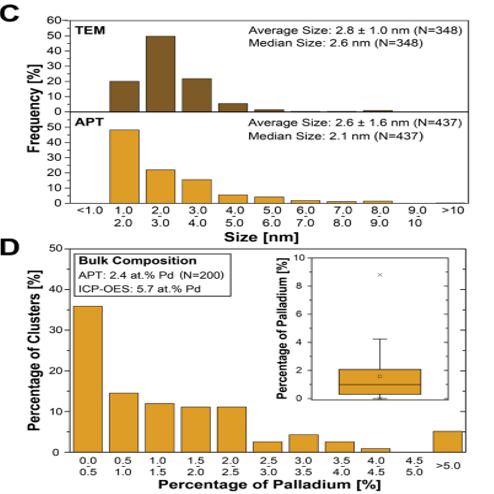
Size, location, and composition of Pd−Ni clusters in reconstructed Pd0.06Ni0.94O/SiO2. (A) Pd (ocher) and Ni (green) atoms within clusters show heterogeneity in Pd distribution; (B) Particle sizes from HAADF-STEM imaging (top) and APT cluster analysis (bottom); (C) distribution of single-cluster Pd concentration, obtained from cluster analysis (for clusters with >300 atoms ≙ 1.85 nm), as NPd,cluster/(NNi,cluster + NPd,cluster). Inset: corresponding box and whisker plot. Average Pd at.% in Ni−Pd nanoparticles was obtained from APT based on total number of atoms in all clusters and from elemental analysis (ICP-OES).
Scientific Achievement
Atom probe tomography (APT) was used to measure the size and composition of 100s of individual NiPd nanoparticles (NPs) supported on mesoporous silica with sub-nm resolution and 10 ppm sensitivity.
Significance and Impact
This work demonstrates, for the first time, the ability to use APT to measure individual NP compositions in an industrial mesoporous oxide-supported metal catalyst materials.
Research Details
- High-pressure resin impregnation was used to fill the mesoporous oxide support containing NPs to create a suitably dense material for the APT experiments.
- Within the APT volume (3 × 105 nm3), 100s of NiPd clusters were identified having compositions ranging from 0-16 at.% Pd and an average diameter of 2.6 ± 1.6 nm.
- This methodology expands the utility of APT to investigate porous functional nanomaterials, including solid catalysts.
F. Zand, et al., Journal of the American Chemical Society 145, 17299-17308 (2023). DOI:10.1021/jacs.3c04474




